Quiche is a fancy tart with a buttery crust and a rich, creamy filling. This salmon variation is easy to make and flavorful, and an excellent dish for brunch, a light lunch, potlucks and picnics. Top it with asparagus or leave it plain. It can be made ahead and refrigerated or frozen for a month.
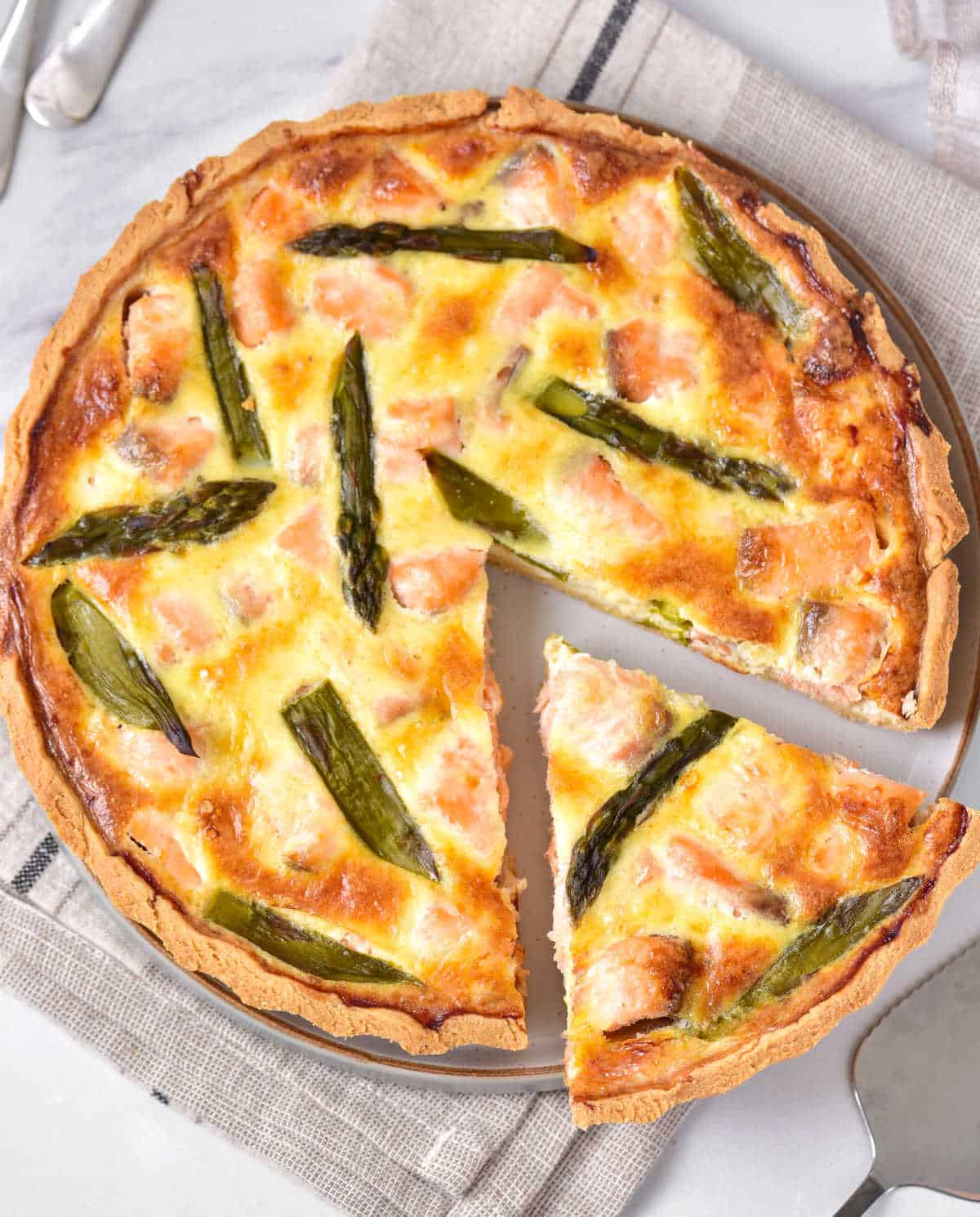
I'm used to making quiche, and like having this salmon version to eat as a light lunch during hot months. A simple green salad is all you need to serve it.
A buttery crust is traditional, but you can also make a crustless salmon quiche, a fantastic recipe for a brunch table that can be gluten-free depending on the add-ins you use.
This versatile salmon quiche recipe uses fresh or smoked salmon and you can experiment with different cheeses, herbs or spices.
What is quiche?
Quiche is the French word for a thin savory tart with a buttery homemade crust. They mainly differ from a pie in their height.
Though round tart pans are traditional, quiche can be made in square pans (like this mushroom tart) or narrow rectangular pans (like the pear almond tart).
It has 3 main components: crust, binding cream, and add-ins.
Vintage Kitchen tip: when it comes to making quiche fillings, it's an excellent way to clean your fridge, pretty much like a frittata or risotto. Most vegetables, cheeses, and deli meats can go into a quiche.
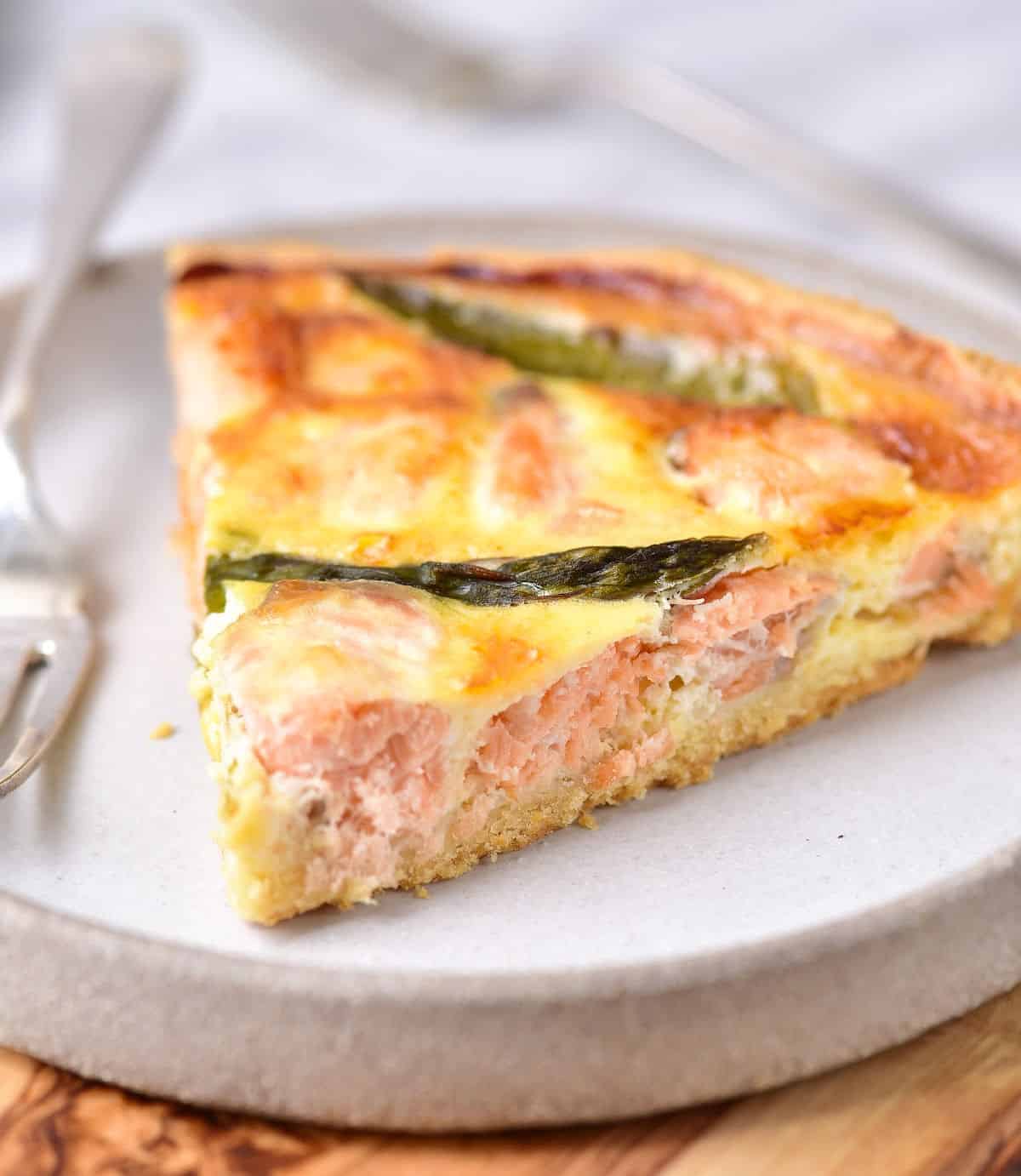
Ingredient list
- Homemade crust: we use our perfect shortcrust pastry, but your favorite neutral pie crust recipe or an all-butter store-bought one works.
- Salmon: fresh or smoked.
- Eggs: fresh.
- Sour cream.
- Cheese: we use white cheddar, Fontina, brie or goat cheese.
- Garlic powder.
- Salt: I like using kosher salt or fine sea salt. But regular table salt works just fine.
- Asparagus stalks or broccoli florets.
See the recipe card towards the end of this post for quantities.
The quiche crust
An all-butter quiche pastry is best, and homemade is highly recommended. It's called pate brisée in French and shortcrust pastry in the UK, and is the most common crust for savory tarts.
My go-to quiche dough has only four ingredients: flour, salt, butter, and ice water. It's a forgiving crust in its assembly and can be rolled easily.
Make it ahead: it keeps in the refrigerator for 3-5 days or a month in the freezer. Always well wrapped.
Quiche pan: this type of savory dish uses a tart pan, unlike most traditional pie pan or plate that holds more filling. You can use either; the pie will have less filling than usual unless you adjust the recipe.
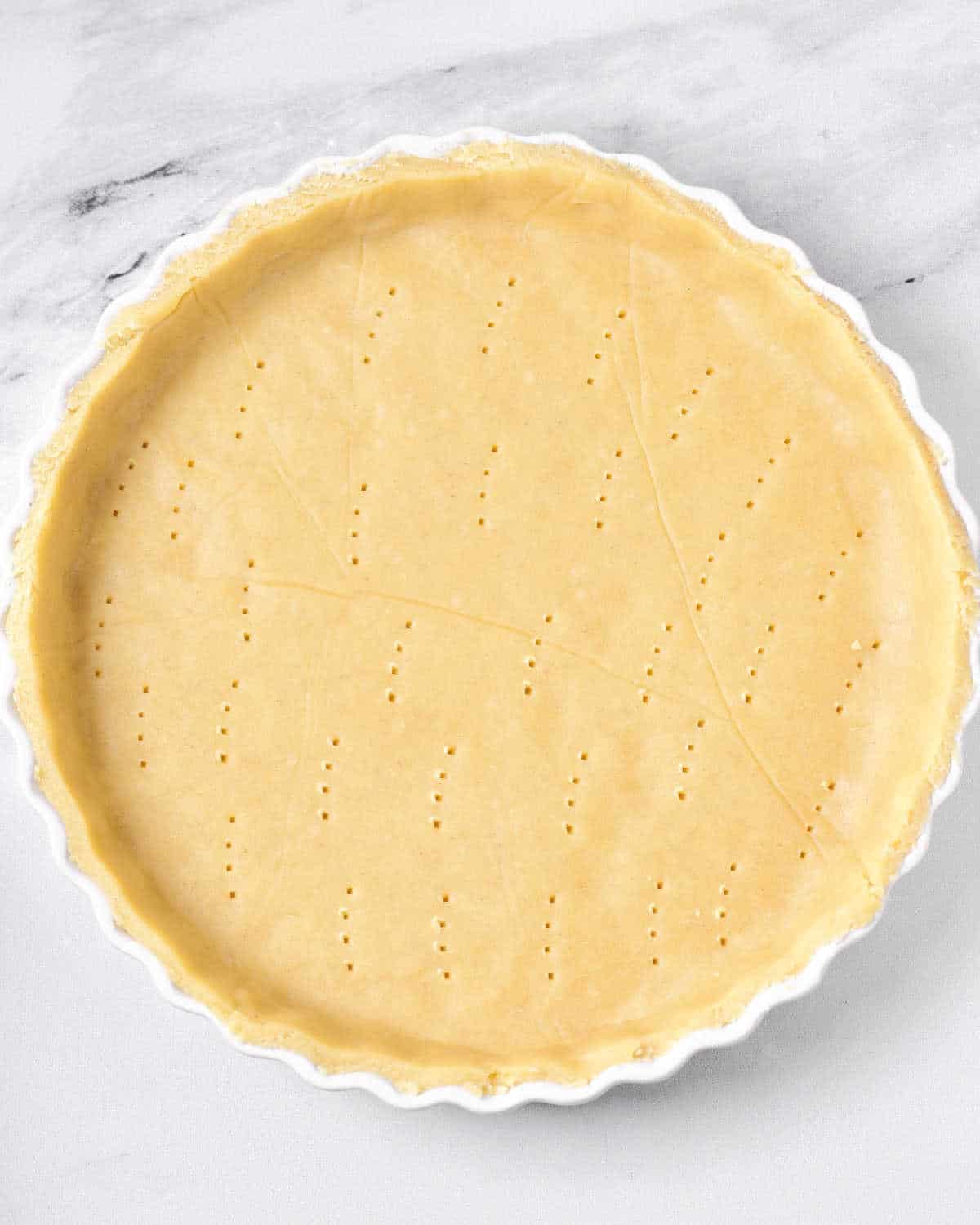
Pricking the dough: this prevents the crust from puffing up too much during baking.
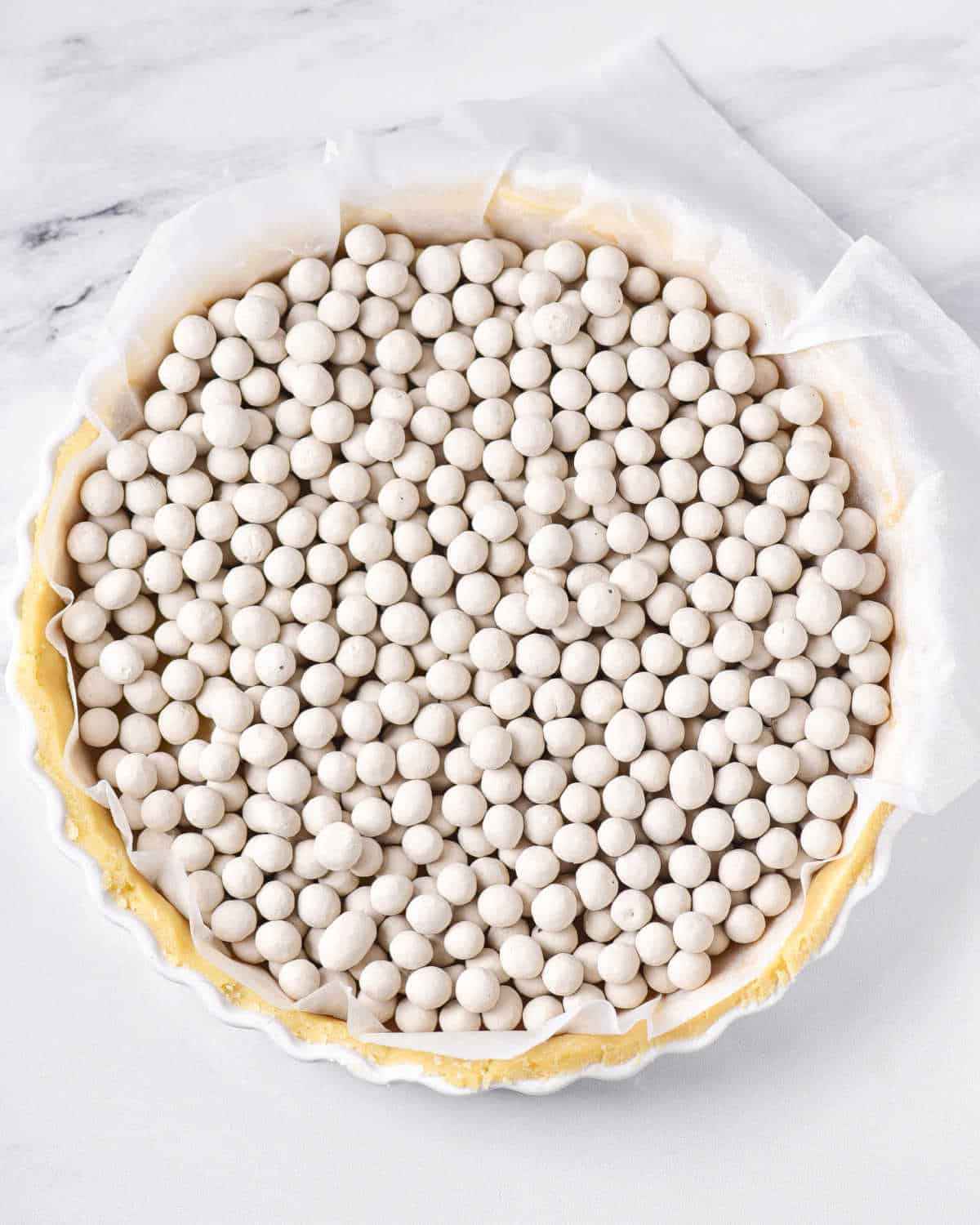
Bling baking the pie crust: it helps to avoid a soggy crust. It's pre-baking the crust with weight on top (pie weights, beans, rice) so that it holds its shape and doesn't shrink. You can read all about blind baking pie dough.
The binding cream
Also called egg custard mixture or egg mixture, it's the glue that makes it all come together, that binds the filling ingredients.
This salmon tart uses a different mixture than my other quiche recipes.
It uses sour cream for tanginess as salmon can be rich, but you can replace it with natural yogurt to make it lighter.
The add-ins
The filling is simple, and, for the sake of this recipe, I wrote down the quantities, of course. But I usually eyeball it. That's what happens when you make quiche regularly.
- Salmon: it's used fresh but know that you can use smoked salmon. I find that it sometimes overcooks and not everyone likes it with cheese, so it's not my favorite substitution.
- Asparagus or broccoli: we used the former for this photos, but both pair well with the fish. You can omit them.
Assembling a quiche
Nobody likes a soggy tart. And that is crucial when making a great quiche.
- Add-ins: it's important not to use watery ingredients. Drain any liquid before filling the crust. They might've collected when you cooked the vegetables or because they're frozen.
- Binding cream: add it at the last minute and pour it slowly and as evenly as possible, covering the salmon.
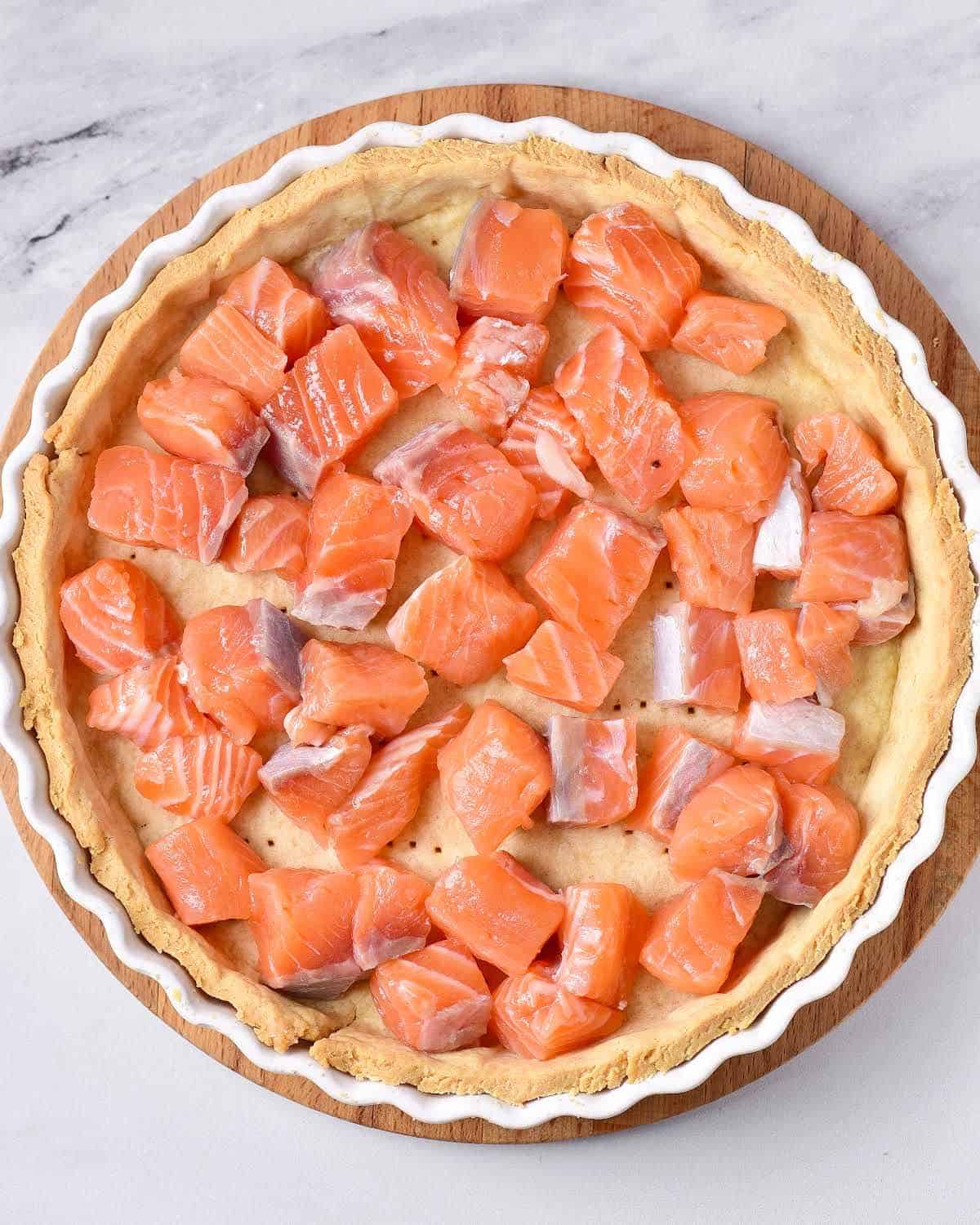
Scatter the salmon pieces on the dough but don't crowd them. You need space for the cream.
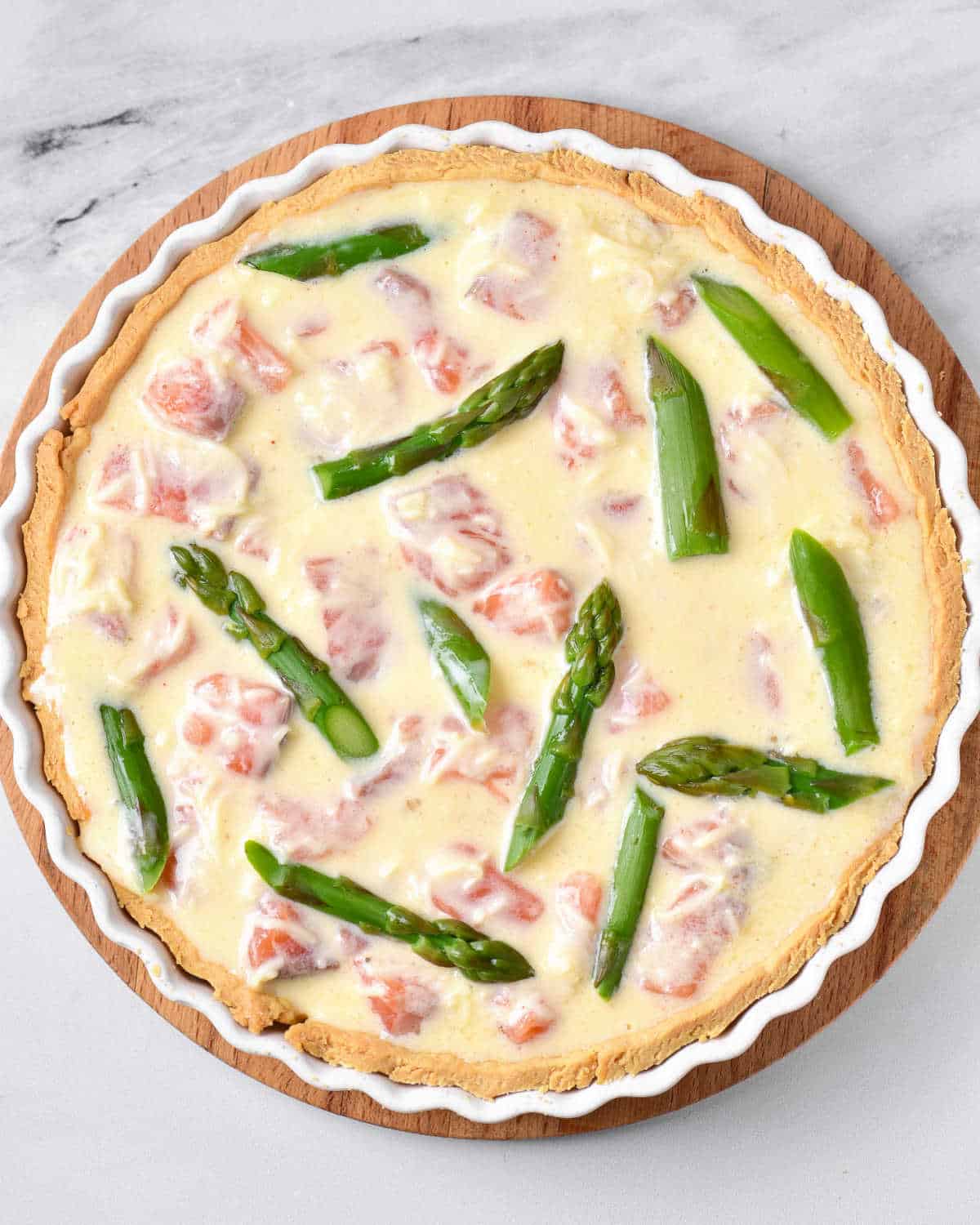
Carefully pour the cream, filling the space left completely. Scatter the asparagus stalks on top.
Variations
- Herbs: use them in the pie dough (as we do for the tomato galette) or the filling. Dill, parsley, tarragon, and basil work well with salmon.
- Binding cream: use Greek yogurt and cream cheese instead of sour cream and cream.
- Spicy: add some smoked paprika or mustard for a slight kick.
- Crust: use a crust with whole wheat flour for a more earthy quiche or use a purchased all-butter puff pastry for a quicker assembly.
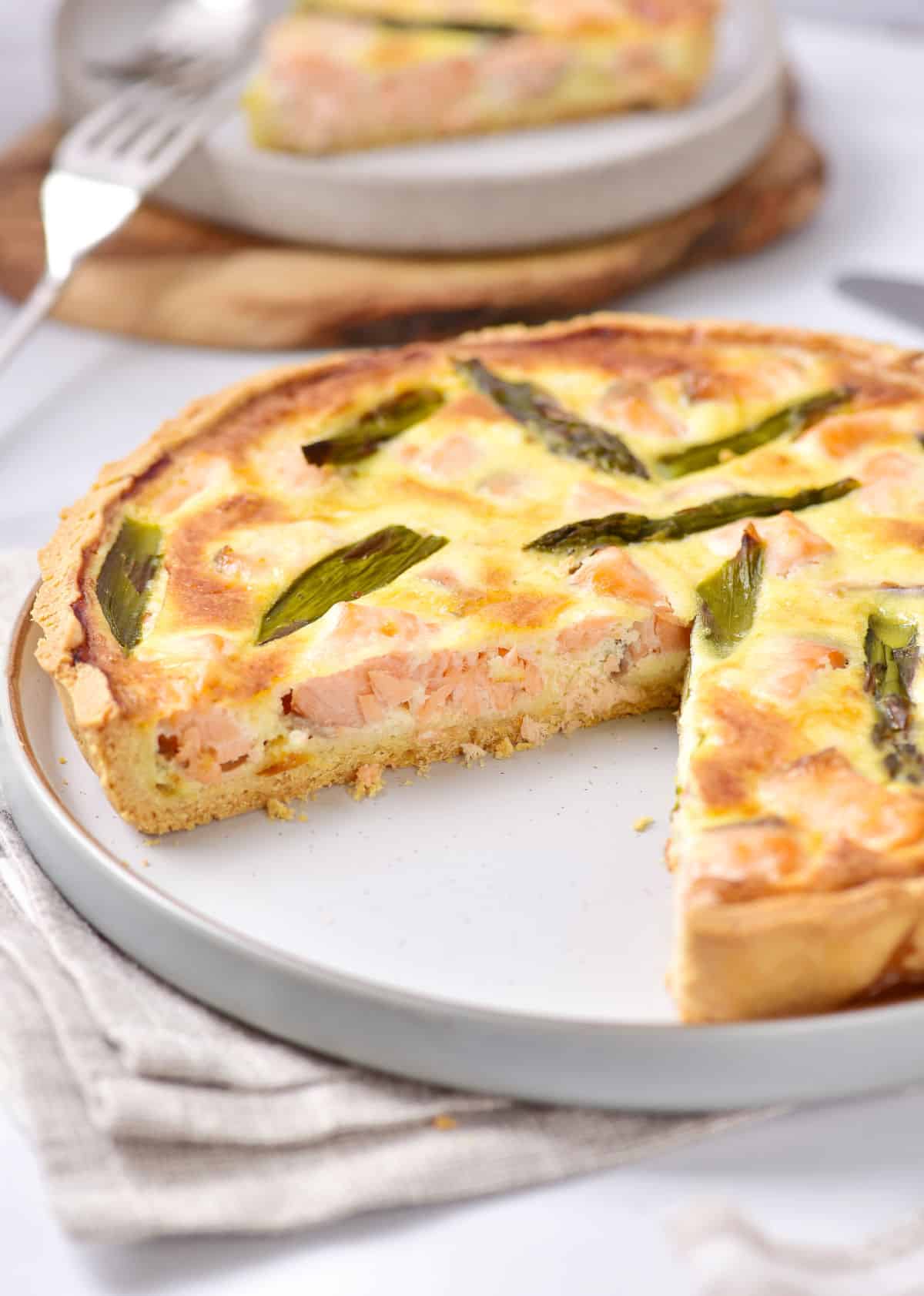
Kitchen notes
- Organization: read the recipe first and ensure you have ingredients at the correct temperature, equipment, and enough workspace. This will make the process so much easier.
- Baking time: consider that all ovens and pans are different, even if they look similar. The baking time in my recipes is as accurate as it can be, but it might take you more or less time. You can use a thermometer(like the OXO oven thermometer) to check that your oven is at the right temperature. I recommend you keep track of how your oven works and what tiny details you might need to adjust.
- Serving: salmon quiche is the perfect dish for lunch with a salad, for a picnic, for a buffet table and, if you make them bite-size, a great appetizer to eat while you mingle holding a cocktail in your other hand. So this is one of my favorite foods for New Year's Eve casual parties with friends because it is amazing at room temperature as finger food!
- Storing: it stays at room temperature for 2-3 days, in the refrigerator for a week, and frozen for a month. Always well covered in plastic wrap or an airtight container to avoid dryness.
- To freeze: wrap the whole baked quiche or leftover pieces in plastic wrap first and then aluminum, or use a freezer-safe container. It keeps for a month. Thaw at room temperature, unwrapped and warm in a medium oven before eating.
- Make ahead: you can make the pie crust up to a week ahead, refrigerate it, or keep it frozen for a month. The whole quiche can be made the day before.
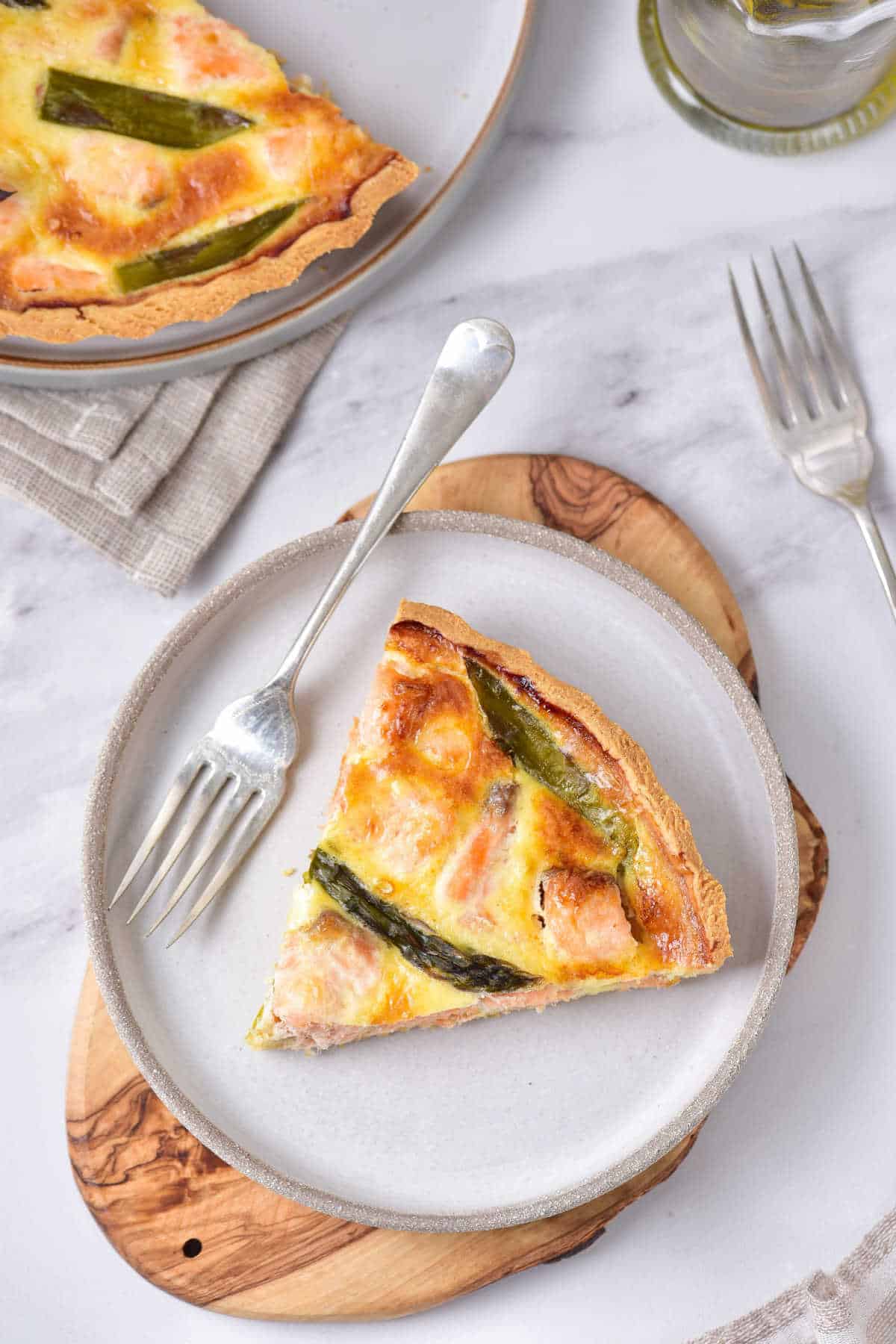
A homemade crust, a good ratio of add-ins and binding cream, and not overbaking it so it stays creamy. Every detail counts to make the best quiche. Take the time to read the recipe first and organize yourself.
Using cream renders a better texture and structure, but it's better to pair it with other dairy (milk, yogurt, sour cream) to avoid a heavy quiche, dense, and too rich. Only milk will produce a filling without enough structure that might take too long to set.
Yes, to avoid sogginess. Blind baking means the crust is pre-baked, creating a dry surface, making it harder for liquids in the filling to immediately start to seep in, making it hard to bake fully.
It usually has to do with an excess of eggs in relation to the rest of the ingredients in the binding cream. For best and constant results, respect the amounts given in the recipe.
Related recipes you might like:
Let me know
If you made this recipe and loved it, you can comment below and leave a five-star ⭐️ review. Also, if you had issues, let me know so we can troubleshoot together. I appreciate honest feedback and suggestions.
You can also subscribe to our FREE email series 'Baking the Best' and our regular newsletter. Or follow and save my recipes on Pinterest.
As an Amazon Associate, I earn from qualifying purchases. Read my disclosure policy.
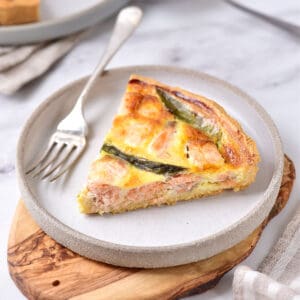
Salmon Quiche (with homemade crust recipe)
Click the stars to Rate this Recipe!
Ingredients
For the tart crust:
- 1 egg
- ¼ teaspoon salt
- 1 ½ cups all-purpose flour
- ½ teaspoon baking powder
- ½ cup cold butter, diced
- 3 tablespoons about cold water
For the filling:
- 1 cup diced fresh salmon, bite-sized pieces
- 2 eggs, at room temperature
- ¼ cup heavy cream
- 2 tablespoons sour cream
- ⅓ cup grated cheddar cheese, fontina, swiss cheese, goat cheese or brie pieces
- ½ teaspoon paprika
- ⅓ teaspoon garlic powder
- ¼ teaspoon salt
- ½ cup asparagus stalks or broccoli florets, cut into pieces
Instructions
For the tart crust:
- Place the flour, salt and baking powder in the jar of the food processor or large bowl if making it by hand. Combine all dry ingredients.
- Scatter cubes of cold butter and process or use your hands or pastry cutter to integrate until the butter is the size of peas and beans. It will be irregular. Don't overprocess. Use short spurts and a spatula or spoon once to move the mixture so it doesn't pool at the bottom.
- Lightly mix the egg with 2 tablespoons of water in a small bowl and add to the flour mixture. Process for a few seconds at a time or mix with a fork until the dough barely comes together. Don't mix or knead until you have a smooth ball at this point.
- Transfer the buttery shaggy dough into a large mixing bowl or a lightly floured counter.
- Add more cold water, a tablespoon at a time, until you have a dough that comes together. The key is to create a smooth ball of dough, touching it as little as possible so you don't warm the butter.
- Wrap the dough disc and refrigerate for 1 hour. At this point, you can freeze it for a month or leave it in the fridge for 5 days, very well wrapped.
- Roll out the dough on a lightly floured surface into a round no more than ¼ inch thick. If more convenient, you can roll the dough between two large sheets of parchment.
- Preheat the oven to 350°F (180°C).
- Line an 8-inch tart pan with removable bottom with the dough, letting it down without stretching it. Remove excess dough from the sides and prick the bottom with a fork.
- Place a large piece of aluminum or parchment paper and top with baking weight, beans, rice or flour. It should fill the pan.
- Bake for 15 minutes, until you can easily and carefully remove the paper with the weight. Bake for 5 more minutes until it starts to dry.
- Let cool for 15 minutes before filling.
For the filling:
- Have the salmon pieces ready.
- In a bowl mix the eggs with the cream and sour cream. Integrate well but don't beat.
- Season with salt, pepper, paprika if using and garlic powder.
- Incorporate the cheese and integrate without beating.
- Place the salmon pieces on the pre-baked crust.
- Carefully pour the binding cream, covering the fish.
- Add the asparagus stalks (or broccoli pieces) on top.
- Bake for another 20-25 minutes, until almost firm in the center and golden brown.
- Allow the quiche to cool slightly on a wire rack before serving.

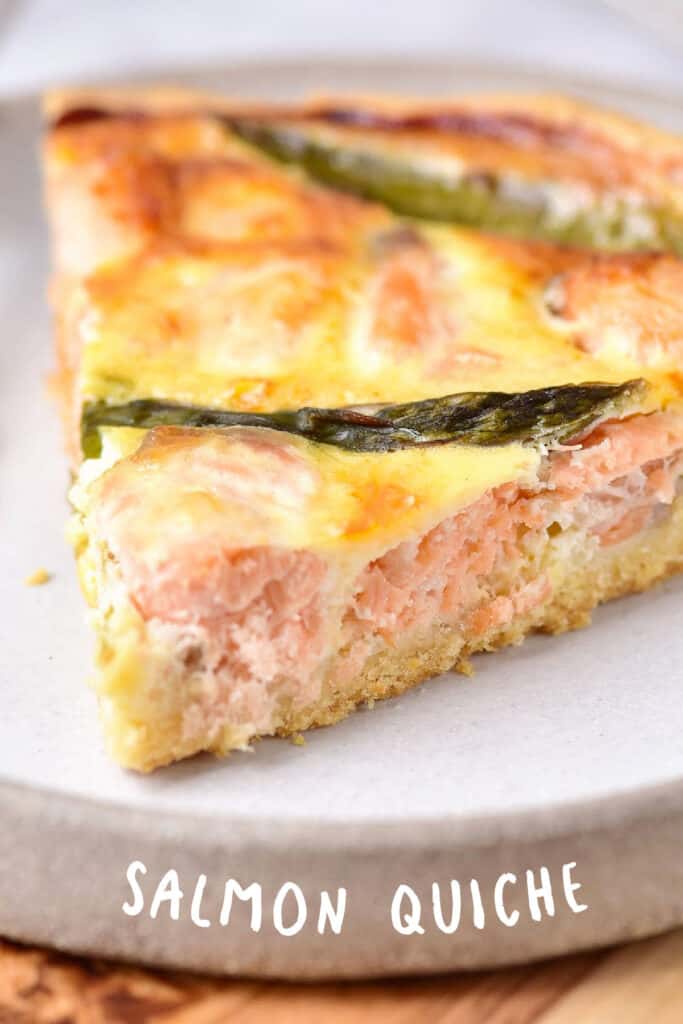
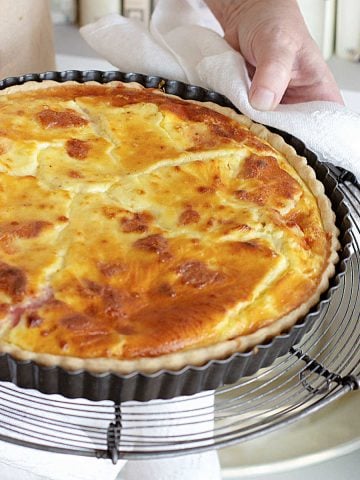
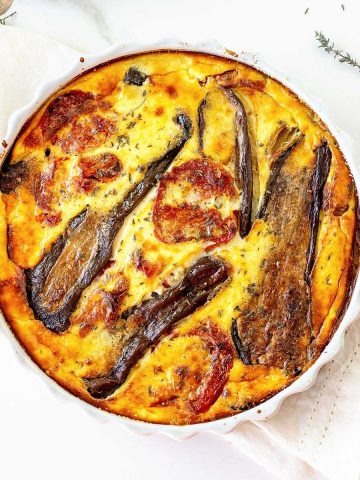
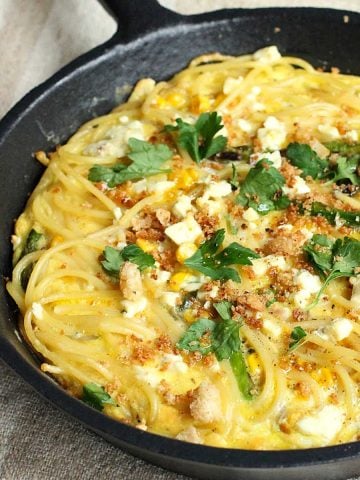
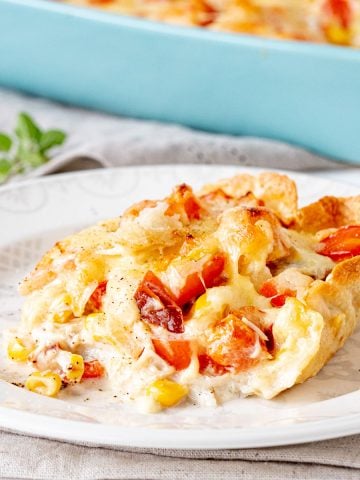
Kitty Gagen says
Is the salmon that goes into the quiche pre=cooked or raw?
Paula Montenegro says
Hi Kitty! You can use fresh, raw salmon (no need to pre-cook it) or smoked.
Verena says
Thanks for the recipe. It was delicious and a hit with everyone.
I thought you may like to know that an error has cr ept into your recipe description. Where it says Spices, it mentions mixing them into the beef mince, lol.
Paula Montenegro says
Thanks Verena for the heads-up!